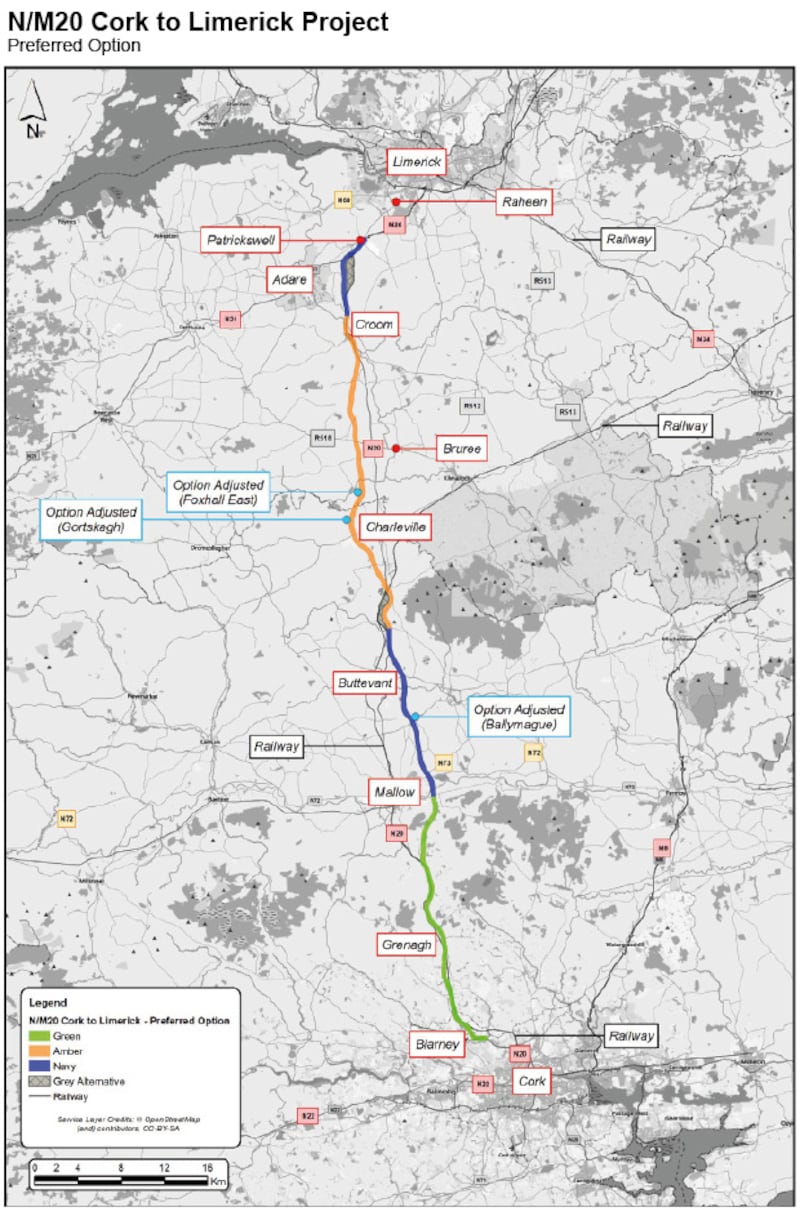The need for improvements to the Cork-Limerick N20 was identified in the 1998 National Roads Needs Study and it was later stated as a government objective in the 2002 National Spatial Strategy and subsequently carried into the 2000-2006 National Development Plan.
In 2008, the National Roads Authority commissioned a study to identify a preferred route corridor for an upgraded carriageway between Cork and Limerick and a route was identified involving bypassing Mallow and Buttevant to the east and Charleville to the west.
The N/M20 Cork to Limerick Motorway Scheme, which was to form part of the government's Atlantic Corridor strategy to link Letterkenny to Waterford, was progressed through planning and design phases and the scheme was submitted to An Bord Pleanála in 2010 for statutory planning approval.

It led to an oral hearing in July 2010 at which Eileen McCarthy, project manager with consultants Arup on behalf of Cork County Council, outlined that there had been 35 deaths on the route between 1996 and 2007 and said the new road would save 70 lives within its first 30 years.
That route, which is broadly similar to the route announced on Wednesday going east of Mallow and Buttevant and west of Charleville, would have required the compulsory purchase of 16 residences and a total of 905 hectares affecting 235 farms and approximately 247 other properties.
The motorway along this route would have involved the construction of 44 new road bridges, eight major river bridges, a number of smaller water crossings and two railway crossings, as well as 64km of local roads including national, regional, local and private-access roads.
However, before An Bord Pleanála could give its determination on the application, the then minister for transport Leo Varadkar instructed the NRA to withdraw its planning application as the government curtailed its capital programme amid falling revenues due to the economic recession.
Since the previous scheme was submitted for planning approval in 2010, the assessment criteria for planning and developing schemes have changed along with changes in European/national policy, environmental legislation, economic appraisal and road infrastructure design requirements.
In April 2019, consultants BSW were appointed to progress the scheme in line with the Transport Infrastructure Ireland Project Management Guidelines including Phase 1, Concept and Feasibility, Phase 2, Options Section, Phase 3, Design and Evaluation and Phase 4, Statutory Processes, including the An Bord Pleanála oral hearing.
The subsequent TII Project Management Guidelines phases for a scheme that is granted planning approval from An Bord Pleanála, include Phase 5, Enabling and Procurement, Phase 6, Construction and Implementation and Phase 7, Close Out and Review.
However, in October 2021, Minister for Transport Eamon Ryan appeared to row back from backing the proposed upgrading of Cork-Limerick motorway status when, speaking prior to the launch of the National Development Plan in Cork, he sounded a note of caution.
He said commitments had been given to improve many roads and funding was finite. “To be honest, there are so many road projects already committed to, if we spent on all of them, we wouldn’t have money for everything but we are not ruling them out, we are not saying definitely ‘no’.”
But on Wednesday Mr Ryan hailed the announcement of transport solutions for connecting Cork and Limerick, including identifying a new route for the upgrade of the N20, as an important step towards improving connectivity between the second and third cities in the State.
“Today’s announcement is an important step forward in progressing a range of transportation solutions connecting Limerick and Cork as identified in the Government’s National Development Plan 2021-2030,” said Mr Ryan.
“It will incorporate public transport and active travel infrastructure for walking and cycling from its inception, as well as to the upgrading of national road infrastructure which will deliver needed safety improvements for all users,” he added.










